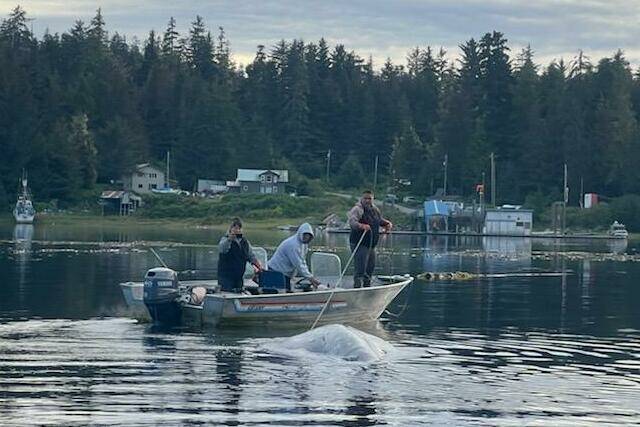What seemed like a photo op turned into a risky rescue effort for an Angoon couple.
On Thursday around 6 p.m., Frank Willis and his girlfriend, Marsha Askoak, were traveling up Favorite Bay to check on shrimp in their crab pots when they saw a gray whale tangled in a rope left over from a broken defunct crab pot. At first their intention was to get close enough to take photos until they realized the whale was stuck. That’s when Willis said they decided to get close enough to try to free the whale themselves.
“I told my girlfriend there were whales in the bay, we love watching them, so she got her camera ready, we saw one and it took a while for it to come back up and when it finally did we thought it was on the surface of the water because we saw something on top,” Willis said. “We went over to it and saw it was dragging a broken crab pot along with kelp. So, I went alongside the rope, grabbed it, and Marsha pulled her knife out and cut the rope while I held onto the end to hopefully get it off and get the whale free.”
It took about an hour, but the duo were eventually able to untangle the whale and remove the rope from its mouth. Willis said they had no plans of giving up until they had succeeded.
Sadie Wright, Alaska region large whale entanglement and oil spill response coordinator with National Oceanic and Atmospheric Administration Fisheries, said that while what Willis did was noble and she’s grateful everything worked out in this instance, but often times the outcome can be much worse, resulting in further harm to the animal as well as the people trying to rescue it.
Instead of attempting a rescue, people who spot a stranded, entangled, injured or dead whale can call NOAA Fisheries’ 24/7 stranding hotline at (877)925-7773.
“People in small communities in Alaska are used to taking the initiative and are often quick to approach an injured animal, in this case a whale, and maybe they haven’t heard of our large whale entanglement program, so we’re trying to do more outreach,” Wright said. “A whale that’s entangled and scared and injured, it can lash out and hurt people very easily and it does happen. People have gotten killed by disentangling whales, so that’s a huge fear for us.”
Callers unable to get through because of a lack of service in a remote area, can call in via VHF on Channel 16 to the Coast Guard, and Wright said the Coast Guard has been great about routing all calls directly to NOAA.
Wright said taking photos is appreciated and helpful so long as people are able to do so while maintaining a safe distance of 100 yards. Wright said the photos can help determine whether the entanglement is life threatening, and if they need to launch a response. Also, staying and monitoring the animal from that safe distance is also helpful, Wright said, because it assists their teams in quickly locating the animal with the appropriate equipment.
“Entanglement is a significant source of injury and mortality to whales in Alaska, and we want to respond to help individual whales when the entanglement is life threatening,” Wright said. “In many cases, whales are able to self-release from entanglements as indicated by the large proportion of the humpback whale population with scars from past entanglements. We ask observers of entangled whales to work closely with our program to assess and document the incidents so we can determine if it is a life threatening event.”
• Contact reporter Jonson Kuhn at jonson.kuhn@juneauempire.com.

